Board Memo 039-2021: Updated Administrative Restructuring Employee Handout
- in News
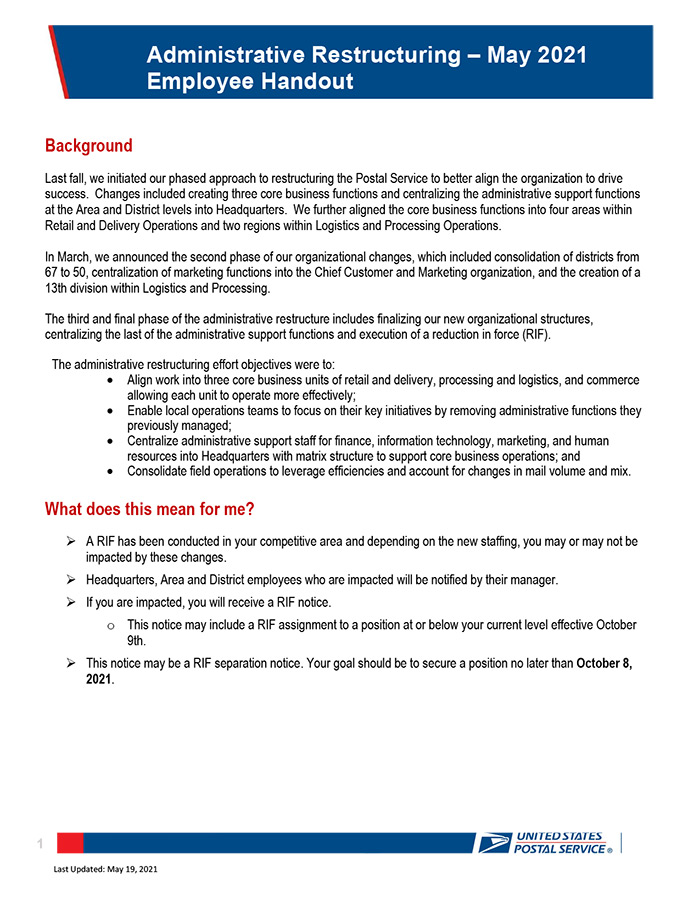
A VIEW FROM THE BRIDGE
WASHINGTON – The Board of Governors of the United States Postal Service today announced its unanimous selection of Louis DeJoy to serve as the 75th Postmaster General of the United States and Chief Executive Officer of the world’s largest postal organization. DeJoy is an accomplished business executive with more than 35 years of experience. As Chairman and CEO of New Breed Logistics, DeJoy spent decades in collaboration with the U.S. Postal Service, Boeing, Verizon, Disney, United Technologies and other public and private companies to provide supply chain logistics, program management and transportation support. He is expected to begin serving in his new role effective June 15th.
“Louis DeJoy understands the critical public service role of the United States Postal Service, and the urgent need to strengthen it for future generations,” said Robert M. (Mike) Duncan, chair of the Board of Governors. “The Board appreciated Louis’ depth of knowledge on the important issues facing the Postal Service and his desire to work with all of our stakeholders on preserving and protecting this essential institution.”
DeJoy becomes the fifth Postmaster General to join the institution from the private sector since the Postal Service became an independent establishment within the Executive Branch in 1971.
“Having worked closely with the Postal Service for many years, I have a great appreciation for this institution and the dedicated workers who faithfully execute its mission. I look forward to working with the supporters of the Postal Service in Congress and the Administration to ensure the Postal Service remains an integral part of the United States government. Postal workers are the heart and soul of this institution, and I will be honored to work alongside them and their unions. It will be an incredible honor to serve as Postmaster General, and I commit myself to upholding the Postal Service’s cherished role in our nation,” said Mr. DeJoy.
As Chairman and CEO of New Breed Logistics, Inc., he transformed a small, family owned transportation company with 10 employees into a nationwide provider of highly engineered, technology-driven, contract logistics solutions employing more than 9,000 people. New Breed Logistics was a contractor to the U.S. Postal Service for more than 25 years, supplying the Postal Service with logistics support for multiple processing facilities. The company received Quality Supplier Awards from the Postal Service in 1995, 1996, 1997 and 1998.
In 2014, New Breed merged with XPO Logistics, with DeJoy serving as CEO of XPO Logistics’ supply chain business in the Americas before retiring in December 2015 as CEO and joining the XPO Logistics board of directors, where he served until 2018.
DeJoy is a member of the Board of Trustees at Elon University in North Carolina and the Fund for American Studies in Washington, DC. He received his Bachelor of Business Administration from Stetson University. He currently resides in Greensboro, North Carolina with his wife, Dr. Aldona Wos.
DeJoy’s appointment comes upon the retirement of Megan Brennan, the nation’s 74th Postmaster General, who announced her intent to step down in October 2019. The Board of Governors then began an extensive nationwide search, employing a national executive search firm to conduct the search with additional advisory services from Chelsea Partners. In the ensuing months, the Governors reviewed the records of more than two hundred candidates for the position before narrowing the list to more than fifty candidates to undergo substantial vetting. Subsequently, the Governors interviewed more than a dozen candidates in first round interviews, and invited seven candidates for follow-up interviews. A narrow list of finalists then underwent a final vetting process before the Governors made their decision.
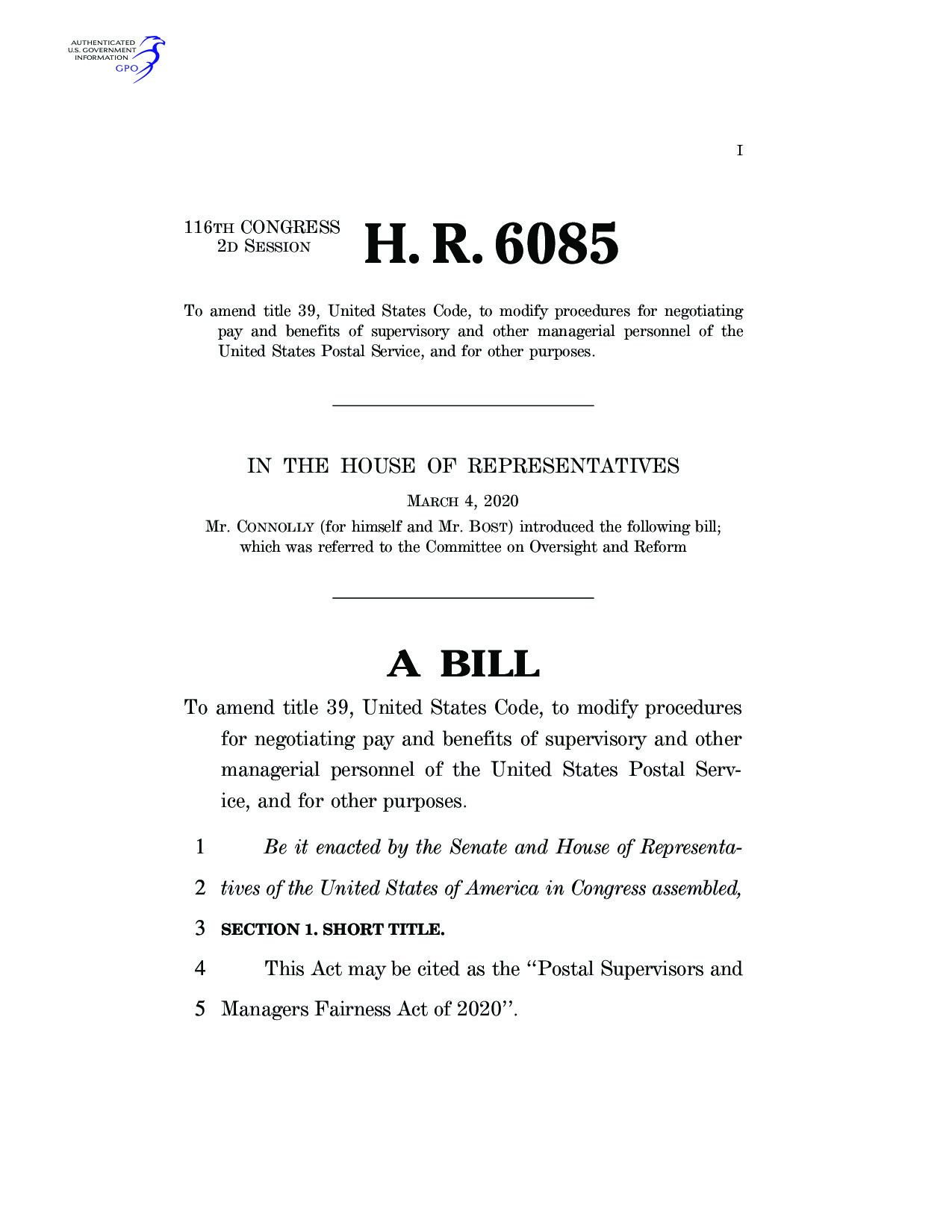


January 31, 2020
It is likely that H.R. 2382, legislation to repeal the onerous requirement that the U.S. Postal Service prepay future retirement health benefits, will receive a House floor vote on Wednesday, February 5. The bill, if enacted into law, would relieve the Postal Service of the unfair and unique burden imposed on it by the 2006 Postal Accountability and Enhancement Act. Past USPS prefunding has contributed to the agency’s operational problems and its inability to invest in its employees and infrastructure. NAPS supports H.R. 2382. However, it is important to note that passage of H.R. 2382 will not solve all the Postal Service’s financial and operational problems. Comprehensive, constructive and meaningful legislation is the path to long-term viability.
Rep. Peter DeFazio (D-OR) introduced H.R. 2382 in April 2019, and the measure was placed on the “Consensus Calendar” in early December. The use of the Consensus Calendar provides the bill with an expedited path to a vote by the full House of Representatives. Presently, H.R. 2382 commands the cosponsorship of 302 members of Congress, approximately 70 percent of the House. NAPS members are to be commended for their efforts to solicit for bill cosponsors. At this time, NAPS members should contact their Representatives to vote “Yes” on passage of H.R. 2382.
S. 2965, the Senate Version of H.R. 2382
Sen. Steve Daines (R-MT) introduced S. 2965, the Senate companion to H.R. 2382. S. 2965 presently has only 2 cosponsors: Sens. Brian Schatz (D-HI) and Ben Cardin (D-MD). NAPS members should contact their Senators to cosponsor the bill. For contact information for Senate offices, click here.
NAPS Legislative Training Seminar Only Weeks Away (March 8-11)
The theme of the 2020 LTS is: “Engaged Minds Producing Legislative Partners.” In effect, NAPS’ legislative effectiveness, whether in our Nation’s Capital or in our home communities, relies on NAPS member engagement in the legislative and political realm. This year’s LTS will equip NAPS members with the tools to be successful in working with members of Congress as legislative partners.
We will engage our elected leaders by educating them about the need to reform the EAS pay consultation process, the need for meaningful and constructive postal legislation, the importance of preserving a government-run postal system, and the necessity to protect postal employee health and retirement benefits from the budget ax. LTS will connect 600 NAPS LTS delegates with their House members and Senators. This year’s LTS takes place in an election year when all 435 House of Representative seats and 35 Senate seats will be decided. So, congressional accountability is front-and-center.
If you have not registered for LTS, it’s still not too late. Please link here to register.
NAPS Submits Comments to PRC on New Rate-Setting Proposal
Today, NAPS submitted comments to the Postal Regulatory Commission concerning the Commission’s proposal to modify postage rates for market domain products. Generally, the PRC proposal would continue to use the consumer price index for urban consumers (CPI-U) as the basis for future rate adjustments. However, it would modify that adjustment by taking into account the reduction of mail per delivery point and the USPS obligation to prefund retiree health benefits. In addition, the USPS could earn enhance modest additional rate flexibility if it meets specified performance targets.
NAPS’ comments urged the PRC to replace the suffocating CPI-U index with a more appropriate index used to measure inflation within the delivery services industry. Over the past 13 years, the CPI-U increased by 3.9%, while the CPI for Delivery Services increased by 11.4%.
Join NAPS Members in Tuning into NAPS Chat
NAPS Chat, the weekly NAPS-produced podcast, recently posted its 62nd episode. Hosted by NAPS Director of Legislative and Political Affairs Bob Levi, guests appearing on the podcast have included NAPS’ resident officers, members of Congress, members of the Postal Regulatory Commission and USPS Board of Governors. You can subscribe to NAPS Chat on iTunes, Spotify, or Google Podcast; or you can go to the NAPS Website.
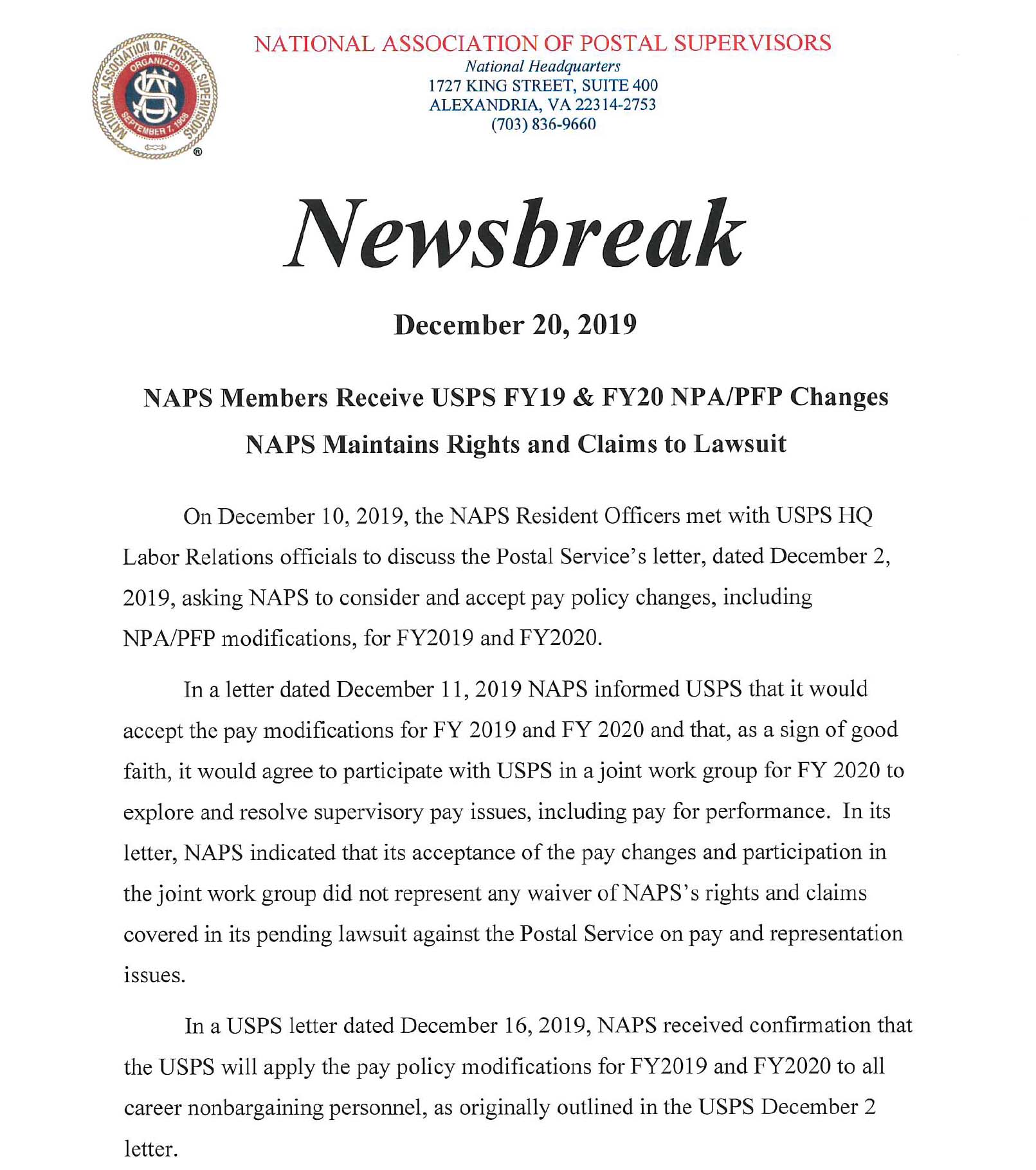
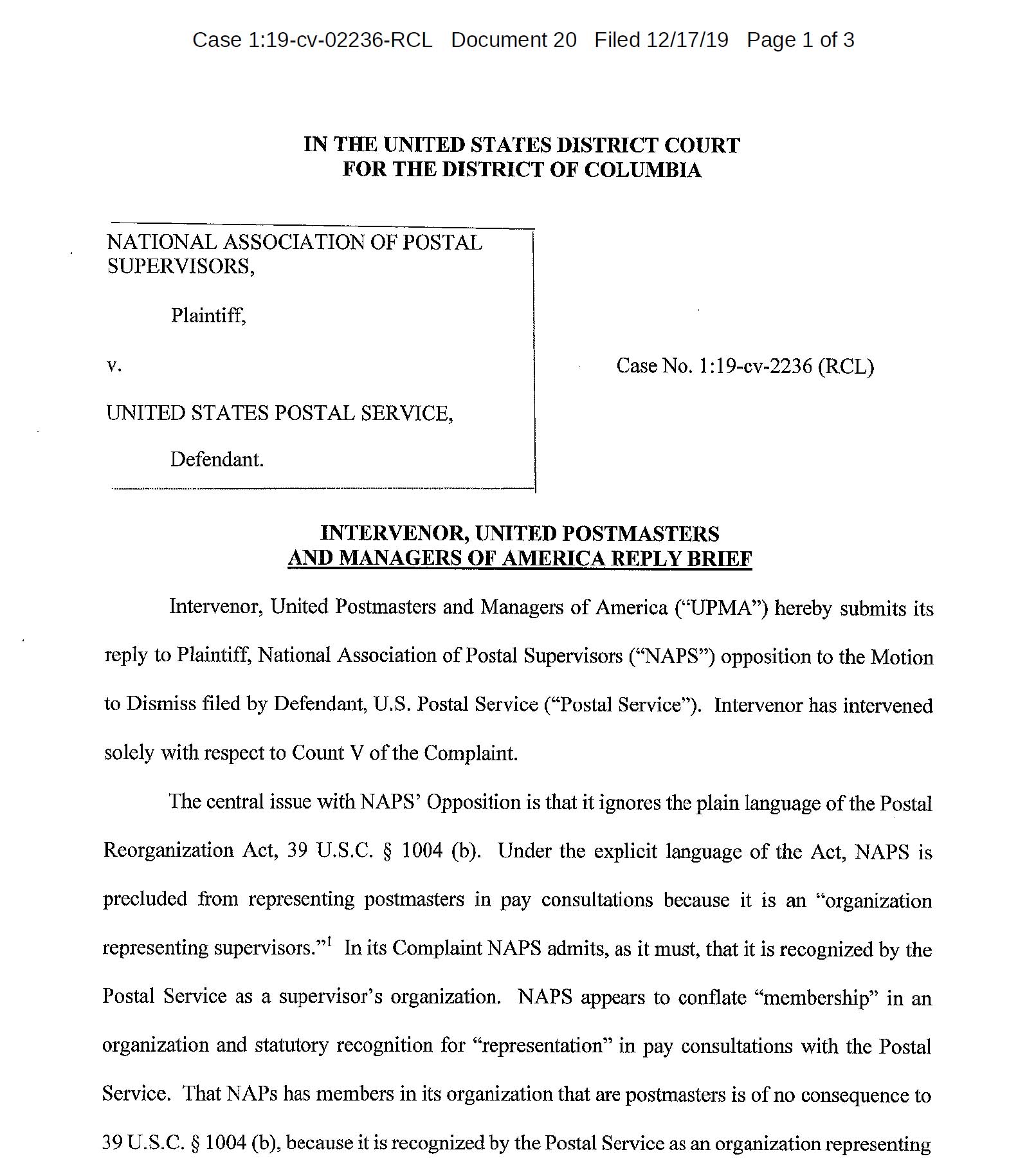
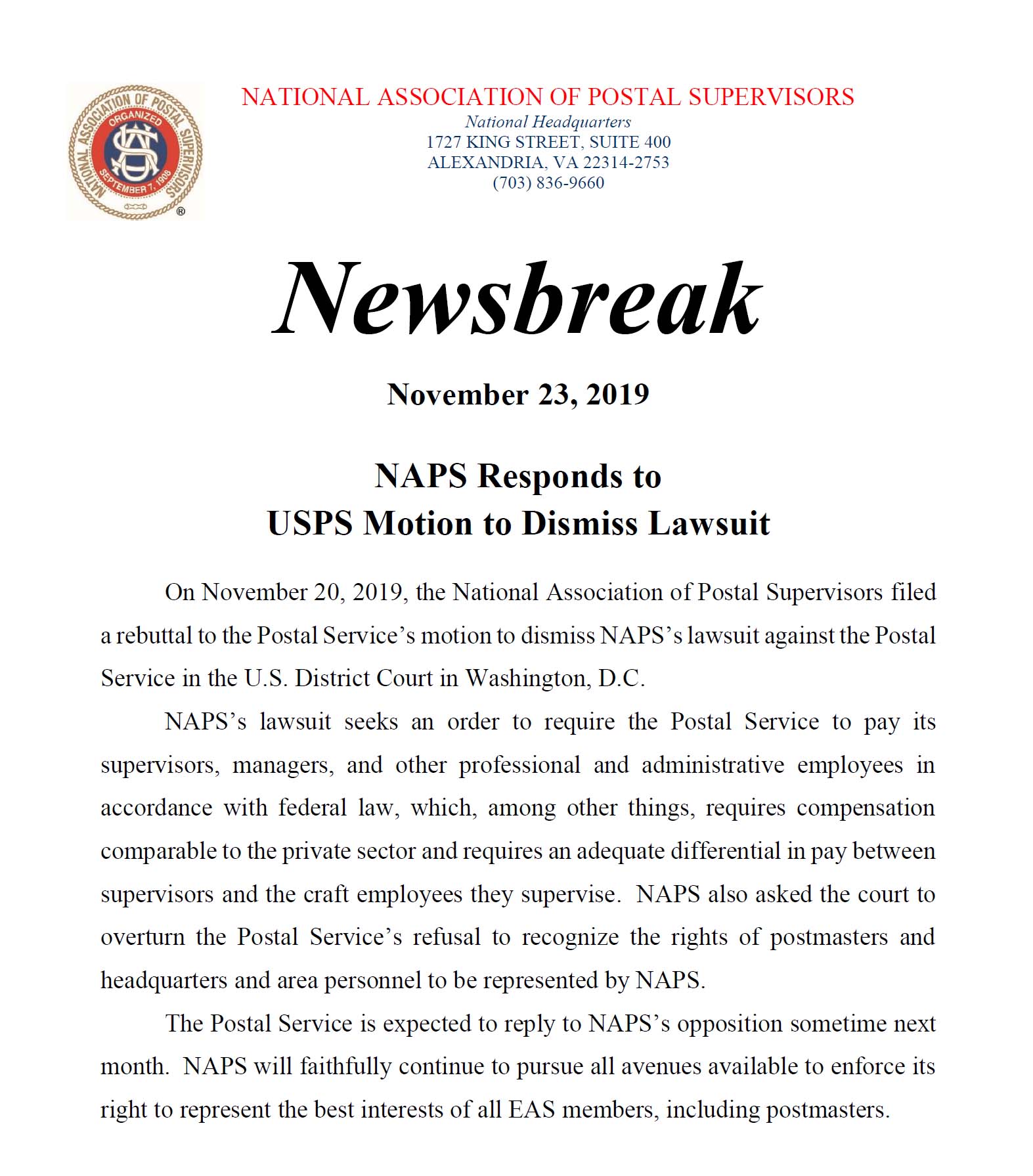
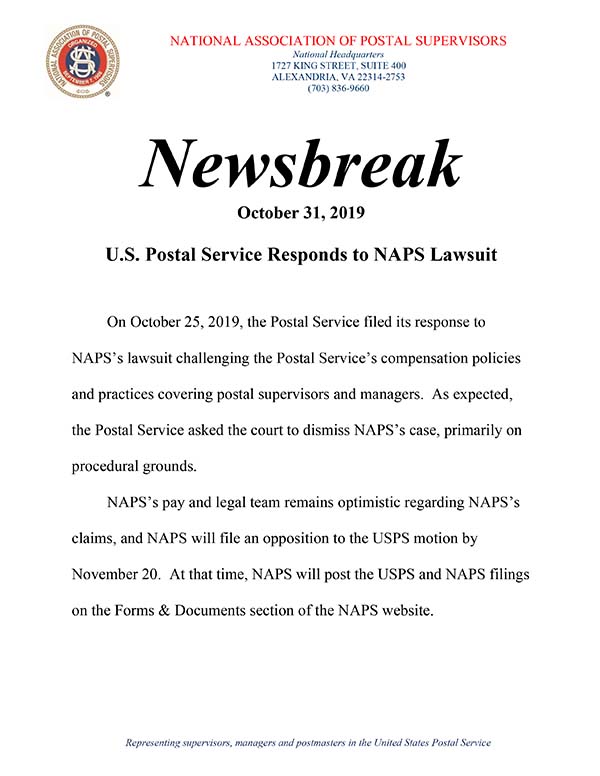

![]()
Viewpoint: How a Broken Pay System Forced Postal Supervisors to Take USPS to Court
By Brian J. Wagner
September 30, 2019
In late July, the National Association of Postal Supervisors filed a federal lawsuit against the U.S. Postal Service, challenging its administration of the pay system that covers approximately 50,000 managers and supervisors. It is the first time in nearly 45 years that NAPS, on behalf of the postal managers and supervisors it represents, has sued the Postal Service over pay.
NAPS went to court because the Postal Service has violated the law’s requirement that it pay managers and supervisors a salary comparable to the pay of their private sector counterparts and that it pay them more than the workers they supervise. These managers and supervisors help to assure the prompt and efficient delivery of mail and the reliability of postal operations. Without a “supervisory differential” in pay, the incentive of craft workers to become supervisors is sorely undermined, and without compensation comparable to the private sector, the Postal Service cannot recruit well-qualified supervisors from outside the Service.
NAPS was prompted to file the lawsuit after the Postal Service in May 2019 issued the final terms of its 2016-2019 pay package for all personnel under the Executive and Administrative Schedule (EAS), which covers the nearly 50,000 managers, supervisors and other middle-management employees who are not members of collective bargaining units. The terms of the Postal Service’s pay package were largely the same as it had first proposed in 2017, before more than a year of “consultation” with NAPS’s leaders and before a review by a three-member fact-finding panel convened in 2018 at NAPS’s request by the Federal Mediation and Conciliation Service. The fact-finding panel extensively reviewed the fairness of the Postal Service’s pay system for its managers and supervisors and unanimously found that the so-called “pay-for-performance” system the Postal Service had devised and applied to all postal managers and supervisors is “seriously flawed.”
Instead of accepting the panel’s recommendations, the Postal Service rejected nearly all of them, resulting in NAPS’s executive board voting unanimously to file a lawsuit contesting the Postal Service’s EAS pay policies and practices. In the lawsuit, filed in federal district court in Washington, NAPS also seeks a court ruling directing the Postal Service to recognize NAPS as a rightful representative of postmasters and EAS Headquarters and Area personnel. Unfortunately, the USPS denial of NAPS’s right to represent all EAS and postmasters is part of a continued effort by USPS executives to “divide and conquer” the EAS mid-level management ranks.
In its April 2019 factfinding report, the federal mediation panel unanimously concurred with NAPS on nearly all matters, strongly validating NAPS’s complaints about Postal Service EAS pay policies. The panel found that the Postal Service’s [pay for performance] system is “seriously flawed in that it does not accomplish its objectives or comport with the requirements of the [Postal Reorganization Act].” It also found that the Postal Service does not properly calculate the supervisory pay differential, which “has resulted in many thousands of Field EAS managers and supervisors receiving less than the Service’s own 5% target differential.” And it found that “the [pay for performance] program negatively impacts the Service’s ability to attract and retain qualified and capable supervisory and managerial personnel and fails to promote the maintenance of a well-motivated workforce.”
Experts in human resources continually stress the importance of worker engagement. Engaged workers create a positive impact on the bottom line of the enterprise, improving customer service, reducing absenteeism, and lowering accidents. The Postal Service has declined to put those principles into action, or even to become alarmed that its own Pulse Survey of the USPS workforce, conducted by Gallup, placed its employees in the bottom percentile of engaged workers in the nation. The Postal Service has taken no meaningful action despite the Gallup survey finding for the past several years that 99% of other large American companies have better employee engagement.
Postal managers and supervisors have grown increasingly frustrated over their pay and the lack of respect given by USPS executives to their role within the organization. At NAPS’s biennial national convention in August 2018, delegate frustration boiled over about the EAS PFP system that has produced years of paltry annual pay increases, including no pay raises for any EAS personnel in 2011 and 2012 and no pay raises for thousands of EAS personnel in 2015, 2017, and 2018. In contrast, all union-covered postal workers receive annual cost-of-living pay adjustments under agreements negotiated with the Postal Service. Further, unlike the rest of the agencies in the federal government, the USPS does not provide area wages or locality pay adjustments to workers in higher-cost areas, such as San Francisco, New York or Washington, D.C.
Now, a federal court will decide whether the panel was correct in finding that the Postal Service has violated—and continues to violate—the law’s requirements.
Brian J. Wagner is national president of the National Association of Postal Supervisors.